-

 40cm x 34cm LimerickJames Pierce was born in Kilmore in 1813. His father had a forge in the village where he learned his ironwork skills. In 1839 James opened a small foundry specialising in making ‘fire fans’ in Allen Street, Wexford at the age of 26. Eight years later in 1847, he moved to the site previously occupied by the Folly Corn Mill at the junction of Distillery Road and Mill Road. Here he established the ‘Folly Mills Iron Works and Agricultural Machinery and Implement Factory’ (later known as the Mill Road Iron Works). In 1856 James was contracted to build a new bridge over the Slaney linking Carcur and Crosstown to replace the old 1795 Wexford Bridge linking the town and Ferrybank. The bridge was over a quarter of a mile long and remained in use for almost 100 years until 1959 when the new Wexford Bridge was built. The Folly Mills Iron Works also forged the elaborately designed iron railings and gates for the twin churches, completed in 1858. He also built the cast-iron conservatories at Castlebridge House and Edermine House (for Sir James Power of the Power Whiskey family). Pierce’s Foundry was further developed when James’s son Philip (d.1895) joined his father to run the firm. They worked together for just two years until James died in 1868. His other sons Martin (d.1907) and John (d.1926) also joined the business and Pierce’s became the largest agricultural machinery manufacturer in the country with a workforce of 1,000 by 1914. They had offices at Rue de Flandre in Paris and in Rio de Janeiro and their products were shipped all over the world. Two other foundries opened in Wexford at either end of the town. The Star Iron Works was established on reclaimed land off Trinity Street and close to the south railway station. Selskar Iron Works was set up also on reclaimed land opposite the north railway station (the site is now occupied by Dunnes Stores). However, commercial success was interrupted in August 1911 during the infamous ‘Lock-Out’ when the Pierces sought to prevent workers from joining the ITGWU. Soon all of the foundries in the town had followed suit leading to a series of pickets and protests which were not resolved until February of the following year. Pierce’s were exporting horse-drawn farm machinery to Africa and North and South America, Australia and across Europe up until the 1920s. They had offices in Paris and Buenos Aires. In the early 1900s Pierce Bicycle Works operated on the site of the earlier Bishopswater Distillery for about 10 years but without great success. When the old distillery was demolished in the 1940s Pierce’s built housing for employees along the street front (Alvina Brook, 1946). They also built houses for senior managers overlooking the foundry at Avenue de Flandre, Mulgannon Road (1939) and at Casa Rio, Distillery Road (1947) for middle management. Park House (originally Ballyboggan House, built c.1780) was the Pierce family home in the north of the town. However, as the use of tractors became more common, Pierce’s failed to modernise and continued to manufacture for the ‘horse era’. The business inevitably declined and in 1964 the Pierce family sold the business. Pierce Engineering’s last owners, Waterford Stanley, closed the plant in 2002 with the loss of 62 jobs. The site was sold to Tesco who opened their supermarket in 2007. The enormous Pierce’s Foundry site
40cm x 34cm LimerickJames Pierce was born in Kilmore in 1813. His father had a forge in the village where he learned his ironwork skills. In 1839 James opened a small foundry specialising in making ‘fire fans’ in Allen Street, Wexford at the age of 26. Eight years later in 1847, he moved to the site previously occupied by the Folly Corn Mill at the junction of Distillery Road and Mill Road. Here he established the ‘Folly Mills Iron Works and Agricultural Machinery and Implement Factory’ (later known as the Mill Road Iron Works). In 1856 James was contracted to build a new bridge over the Slaney linking Carcur and Crosstown to replace the old 1795 Wexford Bridge linking the town and Ferrybank. The bridge was over a quarter of a mile long and remained in use for almost 100 years until 1959 when the new Wexford Bridge was built. The Folly Mills Iron Works also forged the elaborately designed iron railings and gates for the twin churches, completed in 1858. He also built the cast-iron conservatories at Castlebridge House and Edermine House (for Sir James Power of the Power Whiskey family). Pierce’s Foundry was further developed when James’s son Philip (d.1895) joined his father to run the firm. They worked together for just two years until James died in 1868. His other sons Martin (d.1907) and John (d.1926) also joined the business and Pierce’s became the largest agricultural machinery manufacturer in the country with a workforce of 1,000 by 1914. They had offices at Rue de Flandre in Paris and in Rio de Janeiro and their products were shipped all over the world. Two other foundries opened in Wexford at either end of the town. The Star Iron Works was established on reclaimed land off Trinity Street and close to the south railway station. Selskar Iron Works was set up also on reclaimed land opposite the north railway station (the site is now occupied by Dunnes Stores). However, commercial success was interrupted in August 1911 during the infamous ‘Lock-Out’ when the Pierces sought to prevent workers from joining the ITGWU. Soon all of the foundries in the town had followed suit leading to a series of pickets and protests which were not resolved until February of the following year. Pierce’s were exporting horse-drawn farm machinery to Africa and North and South America, Australia and across Europe up until the 1920s. They had offices in Paris and Buenos Aires. In the early 1900s Pierce Bicycle Works operated on the site of the earlier Bishopswater Distillery for about 10 years but without great success. When the old distillery was demolished in the 1940s Pierce’s built housing for employees along the street front (Alvina Brook, 1946). They also built houses for senior managers overlooking the foundry at Avenue de Flandre, Mulgannon Road (1939) and at Casa Rio, Distillery Road (1947) for middle management. Park House (originally Ballyboggan House, built c.1780) was the Pierce family home in the north of the town. However, as the use of tractors became more common, Pierce’s failed to modernise and continued to manufacture for the ‘horse era’. The business inevitably declined and in 1964 the Pierce family sold the business. Pierce Engineering’s last owners, Waterford Stanley, closed the plant in 2002 with the loss of 62 jobs. The site was sold to Tesco who opened their supermarket in 2007. The enormous Pierce’s Foundry site -
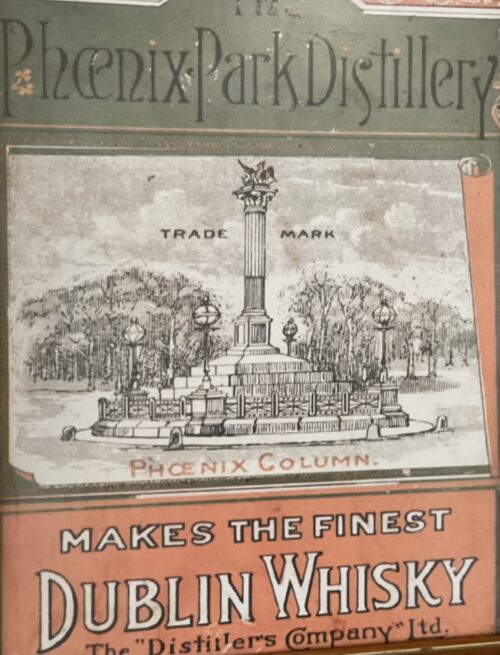
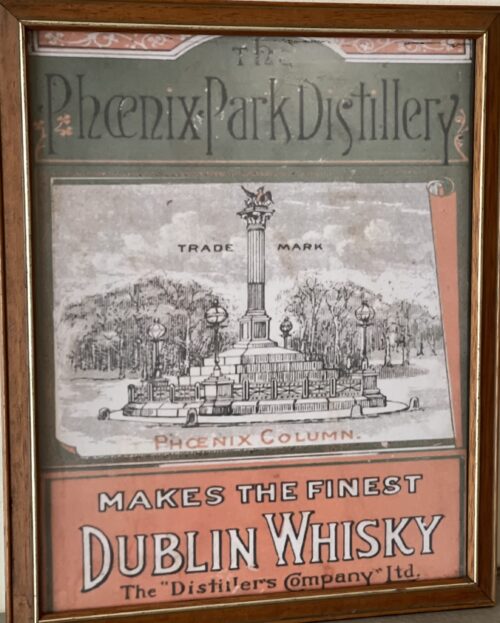 40cm x 34cm Limerick
40cm x 34cm LimerickThe Distillery in Chapelizod, near Dublin's Phoenix Park, was converted from an old mill in 1878 by the Distillers' Company, Ltd., of Scotland, who later went on to become the biggest player in Scotch Whisky owning brands such as Haig, Dewar's, and Buchanan's, as well as countless Malt and Grain Distilleries in Scotland, until the group was taken over by Guinness in the 1980s.
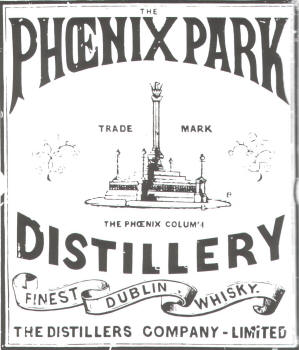 Old Advertisement for Phoenix Park Distillery
Old Advertisement for Phoenix Park DistilleryIt seemed profitable to own an Irish Distillery in those days: Dublin Whiskey, being considered the finest in the world, was priced 25 per cent higher than comparable Scotch Whisky.
The production of Phoenix Park Distillery, 350,000 gallons (1.5 Million Litres) per year, was sold to England and its colonies, as well as used for blending with DCL's own Scottish Malt and Grain Whiskies.
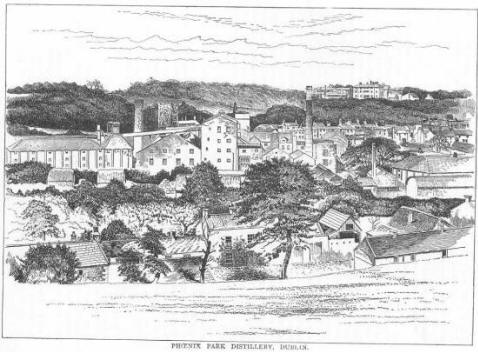 DCL's Phoenix Park Distillery in 1886
DCL's Phoenix Park Distillery in 1886However, Phoenix Park Distillery had only a short life span. Production ceased in 1921, and DCL abandoned the plant a few years later, due to the politically and commercially difficult situation in Ireland at the time.
Today, most buildings have survived, including the mill lade, once holding the largest water wheel in the UK. Others have been converted into apartment houses.
-
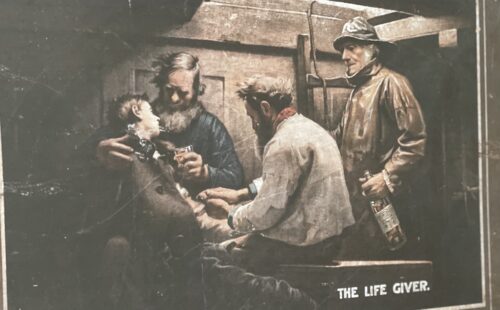
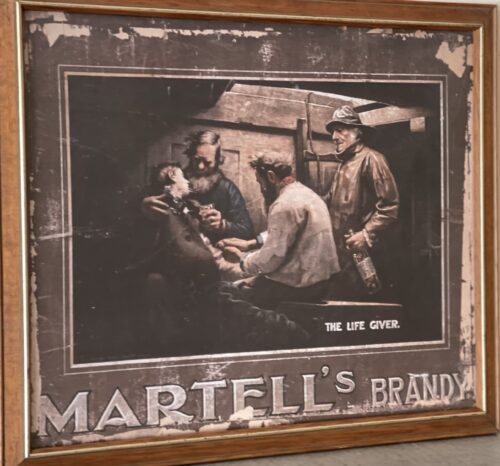 40cm x 34cm Limerick Martell is a Cognac house founded in 1715 by Jean Martell (1694–1753). It is part of the Martell Mumm Perrier-Jouët subsidiary of the French wines and spirits conglomerate Pernod Ricard. In 1715, Jean Martell, a young merchant originally from Jersey, created his own trading business at Gatebourse in Cognac, on the banks of the Charente, and thus founded one of the first cognac houses. Martell used grapes from the vineyards in the Borderie subregion, and used Tronçais oak for its casks, this made a combination that resulted in an exceptionally smooth cognac.After his death in 1753, his widow and then his two sons and grandson continued this tradition and developed the export business to make Martell the number one in England in 1814. In 1831, Martell created his first "VSOP" (Very Superior Old Pale) cognac and continued its international expansion. Its fame spread throughout the world, with the first exports to Japan and other Asian markets, such as Indonesia, Vietnam, Malaysia and Korea. On the coat of arms are what appear to be three small martels or war hammers, but could also be keg mallets. Cordon Bleu, created in 1912, is certainly the company’s most famous product. Martell was served aboard the Queen Mary in 1936 and even on Concorde in 1977. In 1987, Seagram took control of the French manufacturer for $1.2 billion. Since the acquisition of some of the Seagram Group’s spirits in 2001, Martell has belonged to the French spirits group, Pernod Ricard. In the 2000s, Martell created new cognacs: "Martell XO" in 2005, "Martell Création Grand Extra" in 2007, in a bottle designed by the artist and glass designer Serge Mansau. In 2009, Martell cognac launched its signature cognac, "L'Or de Jean Martell". In 2011, Martell expanded its "ultra-prestige" range with an exceptional cognac, "Martell Chanteloup Perspective", a tribute to the know-how of the cellar masters and to the Domaine de Chanteloup. In 2006, Martell joined the Comité Colbert, an association that promotes French luxury houses on an international scale. In 2010, Martell renewed its sponsorship with the Palace of Versailles, which began in 2007, by supporting the restoration of the Queen’s antechamber. In 2012, Martell Cordon Bleu, which was launched by Edouard Martell in 1912 at the Hotel de Paris in Monaco, celebrated its 100th birthday in the same place.
40cm x 34cm Limerick Martell is a Cognac house founded in 1715 by Jean Martell (1694–1753). It is part of the Martell Mumm Perrier-Jouët subsidiary of the French wines and spirits conglomerate Pernod Ricard. In 1715, Jean Martell, a young merchant originally from Jersey, created his own trading business at Gatebourse in Cognac, on the banks of the Charente, and thus founded one of the first cognac houses. Martell used grapes from the vineyards in the Borderie subregion, and used Tronçais oak for its casks, this made a combination that resulted in an exceptionally smooth cognac.After his death in 1753, his widow and then his two sons and grandson continued this tradition and developed the export business to make Martell the number one in England in 1814. In 1831, Martell created his first "VSOP" (Very Superior Old Pale) cognac and continued its international expansion. Its fame spread throughout the world, with the first exports to Japan and other Asian markets, such as Indonesia, Vietnam, Malaysia and Korea. On the coat of arms are what appear to be three small martels or war hammers, but could also be keg mallets. Cordon Bleu, created in 1912, is certainly the company’s most famous product. Martell was served aboard the Queen Mary in 1936 and even on Concorde in 1977. In 1987, Seagram took control of the French manufacturer for $1.2 billion. Since the acquisition of some of the Seagram Group’s spirits in 2001, Martell has belonged to the French spirits group, Pernod Ricard. In the 2000s, Martell created new cognacs: "Martell XO" in 2005, "Martell Création Grand Extra" in 2007, in a bottle designed by the artist and glass designer Serge Mansau. In 2009, Martell cognac launched its signature cognac, "L'Or de Jean Martell". In 2011, Martell expanded its "ultra-prestige" range with an exceptional cognac, "Martell Chanteloup Perspective", a tribute to the know-how of the cellar masters and to the Domaine de Chanteloup. In 2006, Martell joined the Comité Colbert, an association that promotes French luxury houses on an international scale. In 2010, Martell renewed its sponsorship with the Palace of Versailles, which began in 2007, by supporting the restoration of the Queen’s antechamber. In 2012, Martell Cordon Bleu, which was launched by Edouard Martell in 1912 at the Hotel de Paris in Monaco, celebrated its 100th birthday in the same place. -

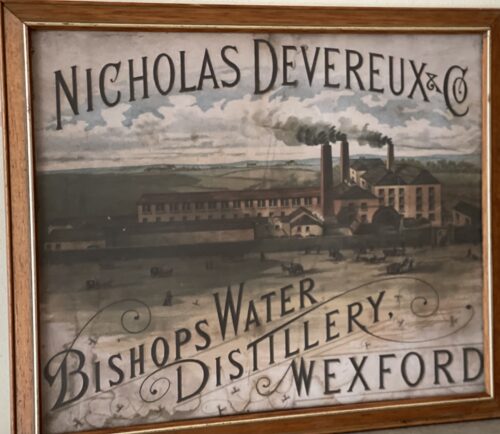 40cm x 34cm LimerickBishops Water Distillery(subsequently known as Nicholas Devereux Finest Irish Whisky) was an Irish whiskey distillery which operated in Wexford, Ireland between 1827 and 1914. The distillery was named for a stream which ran along the back of the distillery, the Bishop's Water, said to possess "various occult properties derived from the blessings of the sainted Bishop of Ferns". Constructed at a cost of £30,000, the distillery was reported to be “reckoned the most perfect and complete of the kind in Ireland”.In 1833, just a few years after it opened, the distillery recorded an output of about 200,000 gallons per annum .However, output had fallen to just 110,000 gallons per annum in 1886, when the distillery was visited by Alfred Barnard, as recorded in his seminal 1887 publication "The Whisky Distilleries of the United Kingdom". This was amongst the lowest output of any distillery operating in Ireland at the time, and far below the potential output of 250,000 gallons per annum reported when the distillery was offered for sale as a going concern in 1909. The distillery's whiskey, Barnard noted, was highly appreciated locally, and in the British cities where it was exported. In the early 20th century, with the Irish whiskey industry in decline, Bishop's Water distillery, like the majority of distilleries in Ireland at the time, suffered serious financial difficulties, and entered bankruptcy. Following its closure, the distillery was initially converted into an iron works (Pierce Ironworks). However, much of the site was later demolished, and little evidence of the distillery still remains. Some mementos can still be found in locals pubs, while a stone archway known to have been extant in 1903 and now bearing the inscription "Casa Rio", possibly in reference to the location of a Pierce ironworks office in Buenos Aires, marks the entrance to the site where the distillery once stood, on Distillery Road. In 1827, a whiskey distillery was established on what is now Distillery Road, Wexford by a consortium of businessmen. The consortium which traded under "Devereux, Harvey, and Co., Distillers", comprised a number of local businessmen, including Nicholas Devereux, his father John Devereux, and Maurice Crosbie Harvey. John Devereux had previously operated a small distillery in the area in the late 1700s, but will little success. In 1830, one of the partners, Maurice Harvey, was accidentally killed at the distillery by an excise man who was taking aim at some birds flying overhead. A few years later, in 1836, the partnership was dissolved at the mutual consent of the remaining partners, with Nicholas Devereux taking sole ownership of the distillery, after which the distillery traded under the name Nicholas Devereux & Son.On his death in 1840, operation of the distillery was taken over by his son Richard. Nichloas Devereux's granddaughter, Mary Anne Therese was also deeply involving in the distilling industry. She married John Locke, founder of the larger Kilbeggan distillery, and successfully took over the business operations of the distillery on his death in 1868. According to Alfred Barnard, the British journalist who visited Bishop's Water in the 1880s, the distillery produced triple-distilled "old pot still whiskey", which was sold locally in Ireland, and also exported to London, Liverpool, and Bristol. At the time of his visit, the Malt Warehouses on-site contained over 16,000 barrels of pure malt. In addition, upwards of 3,000 casks of whiskey were undergoing maturation at the distillery. Whiskey from the distillery is also noted to have been used in the production of blended whiskeys in later years. In the early 20th century, the distillery suffered financial difficulties. In 1907, an attempt was made to appoint a receiver, and in 1909, the distillery was put up for sale, but no takers could be found.In 1914, distilling eventually ceased at the site, and the remaining stocks were sold off.
40cm x 34cm LimerickBishops Water Distillery(subsequently known as Nicholas Devereux Finest Irish Whisky) was an Irish whiskey distillery which operated in Wexford, Ireland between 1827 and 1914. The distillery was named for a stream which ran along the back of the distillery, the Bishop's Water, said to possess "various occult properties derived from the blessings of the sainted Bishop of Ferns". Constructed at a cost of £30,000, the distillery was reported to be “reckoned the most perfect and complete of the kind in Ireland”.In 1833, just a few years after it opened, the distillery recorded an output of about 200,000 gallons per annum .However, output had fallen to just 110,000 gallons per annum in 1886, when the distillery was visited by Alfred Barnard, as recorded in his seminal 1887 publication "The Whisky Distilleries of the United Kingdom". This was amongst the lowest output of any distillery operating in Ireland at the time, and far below the potential output of 250,000 gallons per annum reported when the distillery was offered for sale as a going concern in 1909. The distillery's whiskey, Barnard noted, was highly appreciated locally, and in the British cities where it was exported. In the early 20th century, with the Irish whiskey industry in decline, Bishop's Water distillery, like the majority of distilleries in Ireland at the time, suffered serious financial difficulties, and entered bankruptcy. Following its closure, the distillery was initially converted into an iron works (Pierce Ironworks). However, much of the site was later demolished, and little evidence of the distillery still remains. Some mementos can still be found in locals pubs, while a stone archway known to have been extant in 1903 and now bearing the inscription "Casa Rio", possibly in reference to the location of a Pierce ironworks office in Buenos Aires, marks the entrance to the site where the distillery once stood, on Distillery Road. In 1827, a whiskey distillery was established on what is now Distillery Road, Wexford by a consortium of businessmen. The consortium which traded under "Devereux, Harvey, and Co., Distillers", comprised a number of local businessmen, including Nicholas Devereux, his father John Devereux, and Maurice Crosbie Harvey. John Devereux had previously operated a small distillery in the area in the late 1700s, but will little success. In 1830, one of the partners, Maurice Harvey, was accidentally killed at the distillery by an excise man who was taking aim at some birds flying overhead. A few years later, in 1836, the partnership was dissolved at the mutual consent of the remaining partners, with Nicholas Devereux taking sole ownership of the distillery, after which the distillery traded under the name Nicholas Devereux & Son.On his death in 1840, operation of the distillery was taken over by his son Richard. Nichloas Devereux's granddaughter, Mary Anne Therese was also deeply involving in the distilling industry. She married John Locke, founder of the larger Kilbeggan distillery, and successfully took over the business operations of the distillery on his death in 1868. According to Alfred Barnard, the British journalist who visited Bishop's Water in the 1880s, the distillery produced triple-distilled "old pot still whiskey", which was sold locally in Ireland, and also exported to London, Liverpool, and Bristol. At the time of his visit, the Malt Warehouses on-site contained over 16,000 barrels of pure malt. In addition, upwards of 3,000 casks of whiskey were undergoing maturation at the distillery. Whiskey from the distillery is also noted to have been used in the production of blended whiskeys in later years. In the early 20th century, the distillery suffered financial difficulties. In 1907, an attempt was made to appoint a receiver, and in 1909, the distillery was put up for sale, but no takers could be found.In 1914, distilling eventually ceased at the site, and the remaining stocks were sold off. -
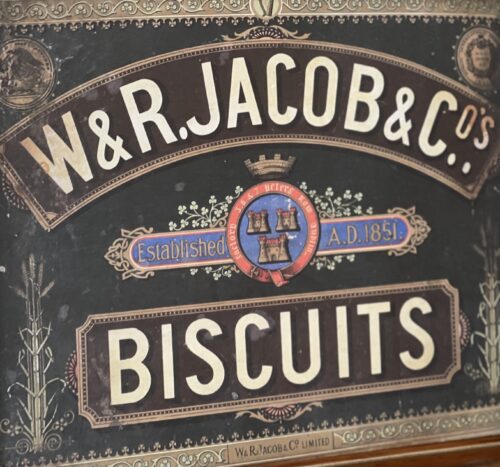
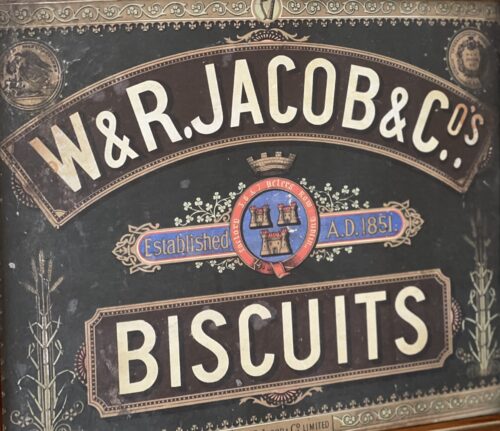 40cm x 34cm LimerickThe biscuit making firm of W. & R. Jacob's were one the largest employers in the Dublin of 1916, and their factory was seized on Easter Monday by perhaps 100 members of the 2nd Battalion of the Dublin Brigade of the Irish Volunteers under Thomas MacDonagh. The factory itself was an enormous and formidable Victorian edifice located on the 'block' enclosed by Bishop St, Bride St, Peter's St and Peter's Row, and between St Patrick's Cathedral and St Stephen's Green. Its seizure helped to complete a loop of building cross the south inner city; the factory had two large towers that could act as observation points, while its location was very close to both Camden St and Patrick St: natural routeways for troops entering the city centre from Portobello Barracks in Rathmines and Wellington Barracks on the South Circular Road. There were only a few staff present in the building when the Volunteers broke into it; a number of smaller outposts were established in the area around the factory. While the garrison saw some fighting early in the week, their principal enemies proved to be boredom and the locals: the factory was surrounded by tenements, and the Volunteers were attacked and abused by residents, many of whom were Jacob's workers themselves. The families of servicemen were also quite hostile, but there may have been another reason for this hostility: Michael O'Hanrahan, who was in Jacob's, expressed his concern that the choice of location might endanger local residents if the British chose to attack. As it happens, the factory was largely by-passed, though it was fired upon intermittently throughout the week by troops in Dublin Castle and elsewhere. MacDonagh surrendered in nearby St Patrick's Park on Sunday 30 April; some of the factory was looted after the Volunteers had left. Three members of the Jacob's garrison were executed. Most of the factory was eventually demolished, though fragments of the ground storey and one of the towers are still visible on Bishop St between the DIT campus on Aungier St and the National Archives of Ireland.
40cm x 34cm LimerickThe biscuit making firm of W. & R. Jacob's were one the largest employers in the Dublin of 1916, and their factory was seized on Easter Monday by perhaps 100 members of the 2nd Battalion of the Dublin Brigade of the Irish Volunteers under Thomas MacDonagh. The factory itself was an enormous and formidable Victorian edifice located on the 'block' enclosed by Bishop St, Bride St, Peter's St and Peter's Row, and between St Patrick's Cathedral and St Stephen's Green. Its seizure helped to complete a loop of building cross the south inner city; the factory had two large towers that could act as observation points, while its location was very close to both Camden St and Patrick St: natural routeways for troops entering the city centre from Portobello Barracks in Rathmines and Wellington Barracks on the South Circular Road. There were only a few staff present in the building when the Volunteers broke into it; a number of smaller outposts were established in the area around the factory. While the garrison saw some fighting early in the week, their principal enemies proved to be boredom and the locals: the factory was surrounded by tenements, and the Volunteers were attacked and abused by residents, many of whom were Jacob's workers themselves. The families of servicemen were also quite hostile, but there may have been another reason for this hostility: Michael O'Hanrahan, who was in Jacob's, expressed his concern that the choice of location might endanger local residents if the British chose to attack. As it happens, the factory was largely by-passed, though it was fired upon intermittently throughout the week by troops in Dublin Castle and elsewhere. MacDonagh surrendered in nearby St Patrick's Park on Sunday 30 April; some of the factory was looted after the Volunteers had left. Three members of the Jacob's garrison were executed. Most of the factory was eventually demolished, though fragments of the ground storey and one of the towers are still visible on Bishop St between the DIT campus on Aungier St and the National Archives of Ireland. -
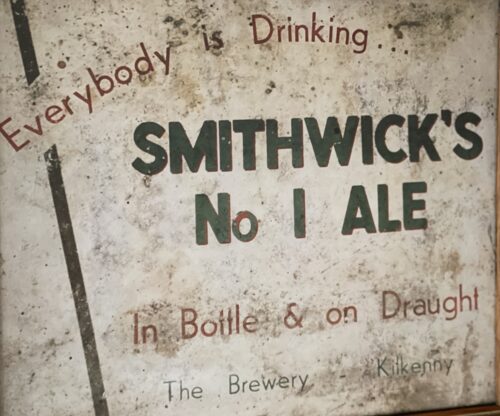
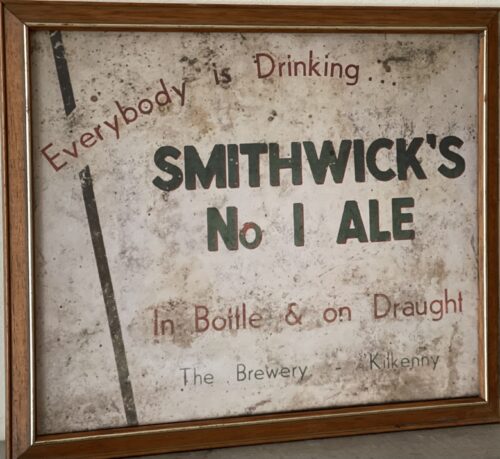 40cm x 34cm LimerickThe old Smithwicks brewery is on the site of a Franciscan abbey, where monks had brewed ale since the 14th century, and ruins of the original abbey still remain on its grounds. The old brewery has since been renovated and now hosts "The Smithwick's Experience Kilkenny" visitor attraction and centre.At the time of its closure, it was Ireland's oldest operating brewery. John Smithwick was an orphan who had settled in Kilkenny. Shortly after his arrival, Smithwick went into the brewing business with Richard Cole on a piece of land that Cole had leased from the Duke of Ormond in 1705. Five years later, John Smithwick became the owner of the land. The brewery stayed small, servicing a loyal local following while John Smithwick diversified. Following John Smithwick's death, the brewery temporarily fell out of family hands. John Smithwick's great grandson, Edmond bought the brewery land back freehold and worked to reshape its future. Edmond concentrated on discovering new markets and successfully building export trade. Drinkers in England, Scotland and Wales developed a taste for Smithwick's brews and output increased fivefold. As a result of substantial contributions made to St Mary's Cathedral, Edmond became great friends with Irish liberal Daniel O'Connell, who later became godfather to one of his sons. Edmond Smithwick became well known and respected by the people of Kilkenny who elected him town mayor four times. In 1800, export sales began to fall and the brewing industry encountered difficulty. To combat this, the Smithwick family increased production in their maltings, began selling mineral water and delivered butter with the ale from the back of their drays.By 1900, output was at an all-time low and the then owner James Smithwick was advised by auditors to shut the doors of the brewery. Instead, James reduced the range of beers they produced and set out to find new markets. He secured military contracts and soon after saw output increase again. James' son, Walter, took control in 1930 and steered the brewery to success through the hardships of both World War II and increasingly challenging weather conditions.By January 1950, Smithwick's was exporting ale to Boston.Smithwick's was purchased from Walter Smithwick in 1965 by Guinness and is now, along with Guinness, part of Diageo. Together, Guinness & Co. and Smithwick's developed and launched Smithwick's Draught Ale in 1966. By 1979, half a million barrels were sold each year.In 1980, Smithwick's began exporting to France. In 1993, Smithwick's Draught became Canada's leading imported ale.By 2010, Smithwick's continued to be brewed in Dundalk and Kilkenny with tankers sent to Dublin to be kegged for the on trade market. Cans and bottles were packaged by IBC in Belfast.Production in the Kilkenny brewery finished on 31 December 2013 and Smithwicks brands are now produced in the Diageo St.James' Gate brewery in Dublin.The original Kilkenny site was sold to Kilkenny County Council, with a small portion of the site dedicated to the opening of a visitor's centre, the "Smithwick's Experience Kilkenny".
40cm x 34cm LimerickThe old Smithwicks brewery is on the site of a Franciscan abbey, where monks had brewed ale since the 14th century, and ruins of the original abbey still remain on its grounds. The old brewery has since been renovated and now hosts "The Smithwick's Experience Kilkenny" visitor attraction and centre.At the time of its closure, it was Ireland's oldest operating brewery. John Smithwick was an orphan who had settled in Kilkenny. Shortly after his arrival, Smithwick went into the brewing business with Richard Cole on a piece of land that Cole had leased from the Duke of Ormond in 1705. Five years later, John Smithwick became the owner of the land. The brewery stayed small, servicing a loyal local following while John Smithwick diversified. Following John Smithwick's death, the brewery temporarily fell out of family hands. John Smithwick's great grandson, Edmond bought the brewery land back freehold and worked to reshape its future. Edmond concentrated on discovering new markets and successfully building export trade. Drinkers in England, Scotland and Wales developed a taste for Smithwick's brews and output increased fivefold. As a result of substantial contributions made to St Mary's Cathedral, Edmond became great friends with Irish liberal Daniel O'Connell, who later became godfather to one of his sons. Edmond Smithwick became well known and respected by the people of Kilkenny who elected him town mayor four times. In 1800, export sales began to fall and the brewing industry encountered difficulty. To combat this, the Smithwick family increased production in their maltings, began selling mineral water and delivered butter with the ale from the back of their drays.By 1900, output was at an all-time low and the then owner James Smithwick was advised by auditors to shut the doors of the brewery. Instead, James reduced the range of beers they produced and set out to find new markets. He secured military contracts and soon after saw output increase again. James' son, Walter, took control in 1930 and steered the brewery to success through the hardships of both World War II and increasingly challenging weather conditions.By January 1950, Smithwick's was exporting ale to Boston.Smithwick's was purchased from Walter Smithwick in 1965 by Guinness and is now, along with Guinness, part of Diageo. Together, Guinness & Co. and Smithwick's developed and launched Smithwick's Draught Ale in 1966. By 1979, half a million barrels were sold each year.In 1980, Smithwick's began exporting to France. In 1993, Smithwick's Draught became Canada's leading imported ale.By 2010, Smithwick's continued to be brewed in Dundalk and Kilkenny with tankers sent to Dublin to be kegged for the on trade market. Cans and bottles were packaged by IBC in Belfast.Production in the Kilkenny brewery finished on 31 December 2013 and Smithwicks brands are now produced in the Diageo St.James' Gate brewery in Dublin.The original Kilkenny site was sold to Kilkenny County Council, with a small portion of the site dedicated to the opening of a visitor's centre, the "Smithwick's Experience Kilkenny". -
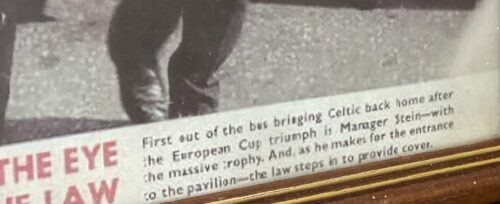
 30cm x 24cm Co Donegal Celtic Football Club is a Scottish professional football club based in Glasgow, which plays in the Scottish Premiership. The club was founded in 1888 with the purpose of alleviating poverty in the immigrant Irish population in the East End of Glasgow. They played their first match in May 1888, a friendly match against Rangers which Celtic won 5–2. Celtic established themselves within Scottish football, winning six successive league titles during the first decade of the 20th century. The club enjoyed their greatest successes during the 1960s and 70s under Jock Stein, when they won nine consecutive league titles and the 1967 European Cup. Celtic have played in green and white throughout their history, adopting hoops in 1903, which have been used ever since. Celtic are one of only five clubs in the world to have won over 100 trophies in their history.The club has won the Scottish league championship 51 times, most recently in 2019–20, the Scottish Cup 40 times and the Scottish League Cup 19 times. The club's greatest season was 1966–67, when Celtic became the first British team to win the European Cup, also winning the Scottish league championship, the Scottish Cup, the League Cup and the Glasgow Cup. Celtic also reached the 1970 European Cup Final and the 2003 UEFA Cup Final, losing in both. Celtic have a long-standing fierce rivalry with Rangers, and the clubs are known as the Old Firm, seen by some as the world's biggest football derby. The club's fanbase was estimated in 2003 as being around nine million worldwide, and there are more than 160 Celtic supporters clubs in over 20 countries. An estimated 80,000 fans travelled to Seville for the 2003 UEFA Cup Final, and their "extraordinarily loyal and sporting behaviour" in spite of defeat earned the club Fair Play awards from FIFA and UEFA.
30cm x 24cm Co Donegal Celtic Football Club is a Scottish professional football club based in Glasgow, which plays in the Scottish Premiership. The club was founded in 1888 with the purpose of alleviating poverty in the immigrant Irish population in the East End of Glasgow. They played their first match in May 1888, a friendly match against Rangers which Celtic won 5–2. Celtic established themselves within Scottish football, winning six successive league titles during the first decade of the 20th century. The club enjoyed their greatest successes during the 1960s and 70s under Jock Stein, when they won nine consecutive league titles and the 1967 European Cup. Celtic have played in green and white throughout their history, adopting hoops in 1903, which have been used ever since. Celtic are one of only five clubs in the world to have won over 100 trophies in their history.The club has won the Scottish league championship 51 times, most recently in 2019–20, the Scottish Cup 40 times and the Scottish League Cup 19 times. The club's greatest season was 1966–67, when Celtic became the first British team to win the European Cup, also winning the Scottish league championship, the Scottish Cup, the League Cup and the Glasgow Cup. Celtic also reached the 1970 European Cup Final and the 2003 UEFA Cup Final, losing in both. Celtic have a long-standing fierce rivalry with Rangers, and the clubs are known as the Old Firm, seen by some as the world's biggest football derby. The club's fanbase was estimated in 2003 as being around nine million worldwide, and there are more than 160 Celtic supporters clubs in over 20 countries. An estimated 80,000 fans travelled to Seville for the 2003 UEFA Cup Final, and their "extraordinarily loyal and sporting behaviour" in spite of defeat earned the club Fair Play awards from FIFA and UEFA. -

 30cm x 30cm If ever a time symbolised flag-waving, delirious, green white and orange national pride, Italia '90 was that time. It all came down to one single glorious moment on a steamy June night in the Stadio Luigi Ferraris in Genoa when Packie Bonner saved that penalty and a deafening Une Voce roar erupted, ricocheting through every home and bar across Ireland. Seconds later when David O'Leary's winning penalty unleashed tears of unbridled joy Irish tricolours billowed like crazy in the breezeless stands and cascaded from the terraces to seemingly endless choruses of 'Olé, Olé, Olé, Olé'. We had made it through to the quarter-finals of the World Cup but we might as well have won and no-one wanted to let that moment go. Back home, cars catapulted onto the streets of every town and village with horns honking and flags wavering precariously from rolled-down windows. In Donegal an impromptu motorcade, suddenly, impulsively headed for Packie's home place in the Rosses, where fans danced in the front garden and waved the tricolour. It was an epic display of patriotic fervour and a defining moment, not just for Irish football but for our sense of identity. Historian and author, John Dorney describes it as the moment when Irish identity and international football collided. In his analysis of the era, he concludes that the Irish team's English manager, Jack Charlton neither knew nor cared about the multiple divisions in Irish society. Likewise, many of the team had been born in England of Irish ancestry and were "a clean slate" without baggage.
30cm x 30cm If ever a time symbolised flag-waving, delirious, green white and orange national pride, Italia '90 was that time. It all came down to one single glorious moment on a steamy June night in the Stadio Luigi Ferraris in Genoa when Packie Bonner saved that penalty and a deafening Une Voce roar erupted, ricocheting through every home and bar across Ireland. Seconds later when David O'Leary's winning penalty unleashed tears of unbridled joy Irish tricolours billowed like crazy in the breezeless stands and cascaded from the terraces to seemingly endless choruses of 'Olé, Olé, Olé, Olé'. We had made it through to the quarter-finals of the World Cup but we might as well have won and no-one wanted to let that moment go. Back home, cars catapulted onto the streets of every town and village with horns honking and flags wavering precariously from rolled-down windows. In Donegal an impromptu motorcade, suddenly, impulsively headed for Packie's home place in the Rosses, where fans danced in the front garden and waved the tricolour. It was an epic display of patriotic fervour and a defining moment, not just for Irish football but for our sense of identity. Historian and author, John Dorney describes it as the moment when Irish identity and international football collided. In his analysis of the era, he concludes that the Irish team's English manager, Jack Charlton neither knew nor cared about the multiple divisions in Irish society. Likewise, many of the team had been born in England of Irish ancestry and were "a clean slate" without baggage. -

 30cm x 30cm Patrick "Pat" O'Callaghan (28 January 1906 – 1 December 1991) was an Irish athlete and Olympic gold medallist. He was the first athlete from Ireland to win an Olympic medal under the Irish flag rather than the British. In sport he then became regarded as one of Ireland's greatest-ever athletes.
30cm x 30cm Patrick "Pat" O'Callaghan (28 January 1906 – 1 December 1991) was an Irish athlete and Olympic gold medallist. He was the first athlete from Ireland to win an Olympic medal under the Irish flag rather than the British. In sport he then became regarded as one of Ireland's greatest-ever athletes.Early and private life
Pat O'Callaghan was born in the townland of Knockaneroe, near Kanturk, County Cork, on 28 January 1906, the second of three sons born to Paddy O'Callaghan, a farmer, and Jane Healy. He began his education at the age of two at Derrygalun national school. O'Callaghan progressed to secondary school in Kanturk and at the age of fifteen he won a scholarship to the Patrician Academy in Mallow. During his year in the Patrician Academy he cycled the 32-mile round trip from Derrygalun every day and he never missed a class. O'Callaghan subsequently studied medicine at the Royal College of Surgeons in Dublin. Following his graduation in 1926 he joined the Royal Air Force Medical Service. He returned to Ireland in 1928 and set up his own medical practice in Clonmel, County Tipperary where he worked until his retirement in 1984.O'Callaghan was also a renowned field sports practitioner, greyhound trainer and storyteller.Sporting career
Early sporting life
O’Callaghan was born into a family that had a huge interest in a variety of different sports. His uncle, Tim Vaughan, was a national sprint champion and played Gaelic football with Cork in 1893. O’Callaghan's eldest brother, Seán, also enjoyed football as well as winning a national 440 yards hurdles title, while his other brother, Con, was also regarded as a gifted runner, jumper and thrower. O’Callaghan's early sporting passions included hunting, poaching and Gaelic football. He was regarded as an excellent midfielder on the Banteer football team, while he also lined out with the Banteer hurling team. At university in Dublin O’Callaghan broadened his sporting experiences by joining the local senior rugby club. This was at a time when the Gaelic Athletic Association ‘ban’ forbade players of Gaelic games from playing "foreign sports". It was also in Dublin that O’Callaghan first developed an interest in hammer-throwing. In 1926, he returned to his native Duhallow where he set up a training regime in hammer-throwing. Here he fashioned his own hammer by boring a one-inch hole through a 16 lb shot and filling it with the ball-bearing core of a bicycle pedal. He also set up a throwing circle in a nearby field where he trained. In 1927, O’Callaghan returned to Dublin where he won that year's hammer championship with a throw of 142’ 3”. In 1928, he retained his national title with a throw of 162’ 6”, a win which allowed him to represent the Ireland at the forthcoming Olympic Games in Amsterdam. On the same day, O’Callaghan's brother, Con, won the shot put and the decathlon and also qualified for the Olympic Games. Between winning his national title and competing in the Olympic Games O’Callaghan improved his throwing distance by recording a distance of 166’ 11” at the Royal Ulster ConstabularySports in Belfast.1928 Olympic Games
In the summer of 1928, the three O’Callaghan brothers paid their own fares when travelling to the Olympic Games in Amsterdam. Pat O’Callaghan finished in sixth place in the preliminary round and started the final with a throw of 155’ 9”. This put him in third place behind Ossian Skiöld of Sweden, but ahead of Malcolm Nokes, the favourite from Great Britain. For his second throw, O’Callaghan used the Swede's own hammer and recorded a throw of 168’ 7”. This was 4’ more than Skoeld's throw and resulted in a first gold medal for O’Callaghan and for Ireland. The podium presentation was particularly emotional as it was the first time at an Olympic Games that the Irish tricolour was raised and Amhrán na bhFiann was played.Success in Ireland
After returning from the Olympic Games, O’Callaghan cemented his reputation as a great athlete with additional successes between 1929 and 1932. In the national championships of 1930 he won the hammer, shot-putt, 56 lbs without follow, 56 lbs over-the-bar, discus and high jump. In the summer of 1930, O’Callaghan took part in a two-day invitation event in Stockholm where Oissian Skoeld was expected to gain revenge on the Irishman for the defeat in Amsterdam. On the first day of the competition, Skoeld broke his own European record with his very first throw. O’Callaghan followed immediately and overtook him with his own first throw and breaking the new record. On the second day of the event both O’Callaghan and Skoeld were neck-and-neck, when the former, with his last throw, set a new European record of 178’ 8” to win.1932 Summer Olympics
By the time the 1932 Summer Olympics came around O’Callaghan was regularly throwing the hammer over 170 feet. The Irish team were much better organised on that occasion and the whole journey to Los Angeles was funded by a church-gate collection. Shortly before departing on the 6,000-mile boat and train journey across the Atlantic O’Callaghan collected a fifth hammer title at the national championships. On arrival in Los Angeles O’Callaghan's preparations of the defence of his title came unstuck. The surface of the hammer circle had always been of grass or clay and throwers wore field shoes with steel spikes set into the heel and sole for grip. In Los Angeles, however, a cinder surface was to be provided. The Olympic Committee of Ireland had failed to notify O’Callaghan of this change. Consequently, he came to the arena with three pairs of spiked shoes for a grass or clay surface and time did not permit a change of shoe. He wore his shortest spikes, but found that they caught in the hard gritty slab and impeded his crucial third turn. In spite of being severely impeded, he managed to qualify for the final stage of the competition with his third throw of 171’ 3”. While the final of the 400m hurdles was delayed, O’Callaghan hunted down a hacksaw and a file in the groundskeeper's shack and he cut off the spikes. O’Callaghan's second throw reached a distance of 176’ 11”, a result which allowed him to retain his Olympic title. It was Ireland's second gold medal of the day as Bob Tisdall had earlier won a gold medal in the 400m hurdles.Retirement
Due to the celebrations after the Olympic Games O’Callaghan didn't take part in the national athletic championships in Ireland in 1933. In spite of that he still worked hard on his training and he experimented with a fourth turn to set a new European record at 178’ 9”. By this stage O’Callaghan was rated as the top thrower in the world by the leading international sports journalists. In the early 1930s controversy raged between the British AAA and the National Athletic and Cycling Association of Ireland (NACAI). The British AAA claimed jurisdiction in Northern Ireland while the NACAI claimed jurisdiction over the entire island of Ireland regardless of political division. The controversy came to a head in the lead-up to the 1936 Summer Olympics when the IAAF finally disqualified the NACAI. O’Callaghan remained loyal to the NACAI, a decision which effectively brought an end to his international athletic career. No Irish team travelled to the 1936 Olympic Games, however O’Callaghan travelled to Berlin as a private spectator. After Berlin, O’Callaghan's international career was over. He declined to join the new Irish Amateur Athletics Union (IAAU) or subsequent IOC recognised Amateur Athletics Union of Eire (AAUE) and continued to compete under NACAI rules. At Fermoy in 1937 he threw 195’ 4” – more than seven feet ahead of the world record set by his old friend Paddy 'Chicken' Ryan in 1913. This record, however, was not ratified by the AAUE or the IAAF. In retirement O’Callaghan remained interested in athletics. He travelled to every Olympic Games up until 1988 and enjoyed fishing and poaching in Clonmel. He died on 1 December 1991.Legacy
O'Callaghan was the flag bearer for Ireland at the 1932 Olympics. In 1960, he became the first person to receive the Texaco Hall of Fame Award. He was made a Freeman of Clonmel in 1984, and was honorary president of Commercials Gaelic Football Club. The Dr. Pat O'Callaghan Sports Complex at Cashel Rd, Clonmel which is the home of Clonmel Town Football Club is named after him, and in January 2007 his statue was raised in Banteer, County Cork. -

 30cm x 30cm Philip Parris Lynott (20 August 1949 – 4 January 1986) was an Irish singer, musician, and songwriter. His most commercially successful group was Thin Lizzy, of which he was a founding member, the principal songwriter, lead vocalist and bassist. He was known for his imaginative lyrical contributions including working class tales and numerous characters drawn from personal influences and Celtic culture. Lynott was born in the West Midlands of England, but grew up in Dublin with his grandparents. He remained close to his mother, Philomena, throughout his life. He fronted several bands as a lead vocalist, including Skid Row alongside Gary Moore, before learning the bass guitar and forming Thin Lizzy in 1969. After initial success with "Whiskey in the Jar", the band had several hits in the mid-1970s such as "The Boys Are Back in Town", "Jailbreak" and "Waiting for an Alibi", and became a popular live attraction combining Lynott's vocal and songwriting skills with dual lead guitars. Towards the end of the 1970s, Lynott embarked upon a solo career, published two books of poetry, and after Thin Lizzy disbanded, he assembled and fronted the band Grand Slam. In the 1980s, Lynott increasingly suffered drug-related problems, particularly an addiction to heroin. In 1985, he had a final chart success with Moore, "Out in the Fields", followed by the minor hit "Nineteen", before his death in 1986. He remains a popular figure in the rock world, and in 2005, a statue in his memory was erected in Dublin.
30cm x 30cm Philip Parris Lynott (20 August 1949 – 4 January 1986) was an Irish singer, musician, and songwriter. His most commercially successful group was Thin Lizzy, of which he was a founding member, the principal songwriter, lead vocalist and bassist. He was known for his imaginative lyrical contributions including working class tales and numerous characters drawn from personal influences and Celtic culture. Lynott was born in the West Midlands of England, but grew up in Dublin with his grandparents. He remained close to his mother, Philomena, throughout his life. He fronted several bands as a lead vocalist, including Skid Row alongside Gary Moore, before learning the bass guitar and forming Thin Lizzy in 1969. After initial success with "Whiskey in the Jar", the band had several hits in the mid-1970s such as "The Boys Are Back in Town", "Jailbreak" and "Waiting for an Alibi", and became a popular live attraction combining Lynott's vocal and songwriting skills with dual lead guitars. Towards the end of the 1970s, Lynott embarked upon a solo career, published two books of poetry, and after Thin Lizzy disbanded, he assembled and fronted the band Grand Slam. In the 1980s, Lynott increasingly suffered drug-related problems, particularly an addiction to heroin. In 1985, he had a final chart success with Moore, "Out in the Fields", followed by the minor hit "Nineteen", before his death in 1986. He remains a popular figure in the rock world, and in 2005, a statue in his memory was erected in Dublin. -

 I 30cm x 30cm Limerick Roy Maurice Keane (born 10 August 1971) is an Irish football manager and former professional player. He is the joint most successful Irish footballer of all time, having won 19 major trophies in his club career, 17 of which came during his time at English club Manchester United. He served as the assistant manager of the Republic of Ireland national teamfrom 2013 until 2018. Regarded as one of the best midfielders of his generation, he was named by Pelé in the FIFA 100 list of the world's greatest living players in 2004.Noted for his hardened and brash demeanour, he was ranked at No. 11 on The Times' list of the 50 "hardest" footballers in history in 2007. Keane was inducted into the Premier League Hall of Fame in 2021. In his 18-year playing career, Keane played for Cobh Ramblers, Nottingham Forest, and Manchester United, before ending his career at Celtic. He was a dominating box-to-box midfielder, noted for his aggressive and highly competitive style of play, an attitude that helped him excel as captain of Manchester United from 1997 until his departure in 2005. Keane helped United achieve a sustained period of success during his 12 years at the club. He then signed for Celtic, where he won a domestic double before he retired as a player in 2006. Keane played at the international level for the Republic of Ireland over 14 years, most of which he spent as captain. At the 1994 FIFA World Cup, he played in every Republic of Ireland game. He was sent home from the 2002 FIFA World Cup after a dispute with national coach Mick McCarthy over the team's training facilities. Keane was appointed manager of Sunderland shortly after his retirement as a player and took the club from 23rd position in the Football League Championship, in late August, to win the division title and gain promotion to the Premier League. He resigned in December 2008,and from April 2009 to January 2011, he was manager of Championship club Ipswich Town. In November 2013, he was appointed assistant manager of the Republic of Ireland national team by manager Martin O'Neill. Keane has also worked as a studio analyst for British channels ITV's and Sky Sportsfootball coverage.
I 30cm x 30cm Limerick Roy Maurice Keane (born 10 August 1971) is an Irish football manager and former professional player. He is the joint most successful Irish footballer of all time, having won 19 major trophies in his club career, 17 of which came during his time at English club Manchester United. He served as the assistant manager of the Republic of Ireland national teamfrom 2013 until 2018. Regarded as one of the best midfielders of his generation, he was named by Pelé in the FIFA 100 list of the world's greatest living players in 2004.Noted for his hardened and brash demeanour, he was ranked at No. 11 on The Times' list of the 50 "hardest" footballers in history in 2007. Keane was inducted into the Premier League Hall of Fame in 2021. In his 18-year playing career, Keane played for Cobh Ramblers, Nottingham Forest, and Manchester United, before ending his career at Celtic. He was a dominating box-to-box midfielder, noted for his aggressive and highly competitive style of play, an attitude that helped him excel as captain of Manchester United from 1997 until his departure in 2005. Keane helped United achieve a sustained period of success during his 12 years at the club. He then signed for Celtic, where he won a domestic double before he retired as a player in 2006. Keane played at the international level for the Republic of Ireland over 14 years, most of which he spent as captain. At the 1994 FIFA World Cup, he played in every Republic of Ireland game. He was sent home from the 2002 FIFA World Cup after a dispute with national coach Mick McCarthy over the team's training facilities. Keane was appointed manager of Sunderland shortly after his retirement as a player and took the club from 23rd position in the Football League Championship, in late August, to win the division title and gain promotion to the Premier League. He resigned in December 2008,and from April 2009 to January 2011, he was manager of Championship club Ipswich Town. In November 2013, he was appointed assistant manager of the Republic of Ireland national team by manager Martin O'Neill. Keane has also worked as a studio analyst for British channels ITV's and Sky Sportsfootball coverage.








